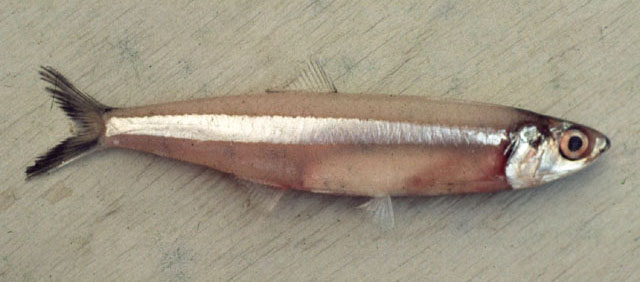| Engraulidae (Anchovies), subfamily: Engraulinae |
| 15.5 cm SL (male/unsexed) |
|
pelagic-neritic; brackish; marine; depth range 20 - 50 m, oceanodromous |
| Indian Ocean: from the Red Sea to Ranong and Phuket, Thailand. |
|
Dorsal spines (total): 0-0; Dorsal soft rays (total): 15-17; Anal spines: 0-0; Anal soft rays: 19-21. Diagnosis: Body slender, elongate, rather round in cross-section, belly rounded, with 2-6 small needle-like pre-pelvic scutes; maxilla tip pointed, reaching to or only just beyond front border of pre-operculum; hind border of pre-operculum convex, rounded; lower gillrakers 20-28; isthmus muscle tapering evenly forward to hind border of branchial membrane; pelvic fin tips not reaching to below dorsal fin origin; anal fin short, with usually 3 unbranched and 16-18 branched finrays, its origin below centre of dorsal fin base; body light transparent fleshy brown, with a silver stripe down flank; no dark pigment lines on back between head and dorsal fin (Ref. 189). Other species with such a short maxilla are Stolephorus advenus, with 7 pre-pelvic scutes, and S. pacificus, with 35-38 gillrakers; maxilla to or almost to hind border of pre-operculum in other Stolephorus species (Ref. 189).
Description: Body slender, elongate, rather round in cross-section, belly rounded (Ref. 189). Tip of upper jaw bluntly pointed; maxilla short, not reaching to gill opening, only to front margin of preopercle (Ref. 2871, 5430, 30573). Isthmus continuous, no silvery plate (Ref. 2871). Lower gill rakers 20-28 (Ref. 189, 5430). Pelvic-fin tip not reaching to dorsal-fin origin; anal-fin origin below dorsal-fin base; Dorsal fin with 3 unbranched and 12-14 branched rays; anal fin with 3 unbranched and 16-18 branched rays; pectoral fin with 1 unbranched and 12-15 branched rays; pelvic fin with 1 unbranched and 6 branched rays (Ref. 5430, 30573). Scales: 38-42 lateral line scales (Ref. 5430). With 2-6 small needle-like pre-pelvic scutes, no post-pelvic scutes (Ref. 189, 5430, 30573).
Colouration: Body light transparent fleshy brown, with a silver stripe down flank; no dark pigment lines on back between head and dorsal fin (Ref. 189). |
| A schooling species occurring in coastal waters and which appears to enter at least the estuarine parts of rivers and to tolerate brackish water. Coastal pelagic (Ref. 68964). Feeds most likely on zooplankton, but more data needed. Used as bait in the tuna fishery in the South Pacific, although said to be fragile. Also Ref. 58652. |
|
Least Concern (LC); Date assessed: 02 March 2017 Ref. (130435)
|
| harmless |
Source and more info: www.fishbase.org. For personal, classroom, and other internal use only. Not for publication.
